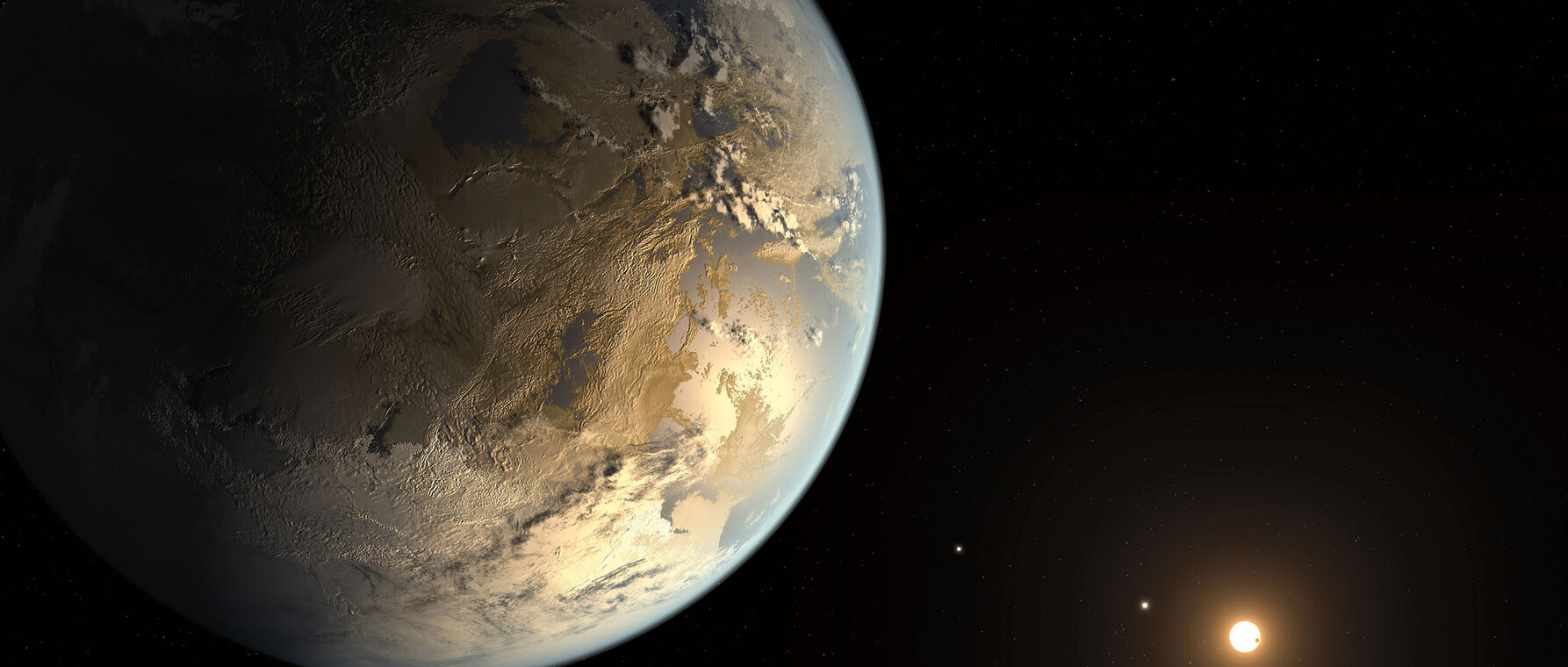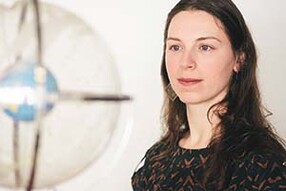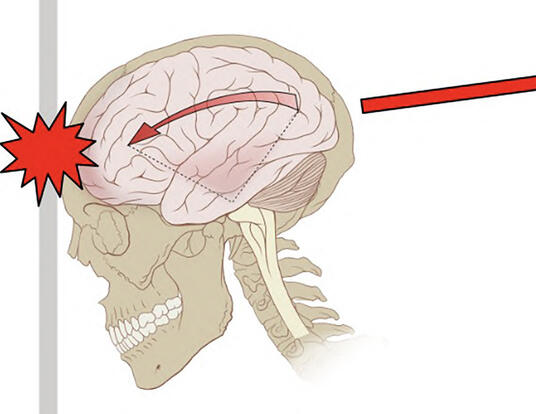Are We Alone in the Universe?
(And why do we care so much?)

Research at Risk: Since World War II, universities have worked with the federal government to create an innovation ecosystem that has yielded life-changing progress. Now much of that work may be halted as funding is withdrawn. Find out more about the threats to medical, engineering, and scientific research, as well as how Harvard is fighting to preserve this work—and the University's core values.
When they first began their science careers, neither Phillips Professor of Astronomy Dimitar Sasselov nor sixth-year graduate student Elisabeth Newton intended to search for extraterrestrial life—but that is exactly what they are both doing today.
“My initial interest was in the physics of stars and cosmology,” says Sasselov.
“I majored in physics in college,” says Newton, “and astronomy offered the most interesting physics.”
Now working at the Harvard-Smithsonian Center for Astrophysics (CfA), Sasselov and Newton are engaged in a quest to answer one of the most fundamental questions facing humanity: Are we unique—and alone— in the universe, or are we ordinary, with an expansive social network waiting for us “out there?”
Sasselov, Newton, and their colleagues now believe that the answer to that question is tantalizingly close after thousands of years of speculation, theorizing, and—finally— some solid scientific research.
The Debate
What at first appears to be a very modern query is actually ancient in its origins. Since human beings began to ponder the “big questions,” the desire to understand what exists beyond the confines of the Earth continually surfaces. According to Michael J. Crowe (author of The Extraterrestrial Life Debate 1750–1900), no less a philosopher than Aristotle argued in the 4th century BCE that a so-called “plurality of worlds” could not exist because every solar system required a Prime Mover to keep it going, and he had trouble imagining an infinite number of those.
Since human beings began to ponder the “big questions,” the desire to understand what exists beyond the confines of the Earth continually surfaces
Around the same time, Epicurus penned a remarkably modern rejoinder to the Aristotelian perspective. He suggested that atoms were infinite in number and argued that “…there are infinite worlds both like and unlike ours.” Epicurus asserted that some of these worlds would sustain life similar to Earth.
Aristotle and Epicurus shared common ground in that they had absolutely no observational data on which to base their opinions, meaning that the controversy surrounding the possibility of extraterrestrial life raged on right through the Middle Ages and Renaissance up to our own time.
For example, Cornell Professor Carl Sagan, whose Public Television series Cosmos brought the concepts of astronomy to a broad audience, advanced a principle of mediocrity that echoed the writings of Epicurus. He argued that there was nothing special about our solar system or planet—there are billions and billions of stars in the universe, with many planets capable of sustaining life and intelligence.
Cosmologists John D. Barrow and Frank J. Tipler countered with the Anthropic Cosmological Principle, arguing that even with a universe full of planets, generating life on one is difficult—and it’s a big leap from single-celled organisms to large-brained mammals who can debate cosmology. We should therefore reserve judgment as to whether we are alone or only one overachieving species among many.
Aristotle and Epicurus would be impressed to find that their argument continues 2,000 years after their deaths.
The Breakthrough

Until 1992, we couldn’t say with certainty whether any planets existed outside our own solar system. This all changed, however, with the confirmed sighting of several such planets (known as extrasolar or exoplanets) orbiting the dense remnant of a supernova explosion in the constellation Virgo. While few believed that these highly irradiated, hostile worlds could support life, their mere existence set off the first of several tectonic shifts in thinking in the field.
In 1995, astronomers announced the first exoplanet orbiting a star similar to our Sun. A rush of discovery followed, accelerating in 2009, when NASA launched the Kepler space-based telescope to search for nearby Earth-like planets. By late 2015, researchers had found nearly 2,000 exoplanets in all, with a growing number of them similar to Earth. Most were detected by Kepler, located via a technique known as the transit method.
When a planet passes—or transits—in front of its sun, the starlight dims perceptibly. Exoplanet hunters can determine many things about their quarry from this simple piece of information, including the planet’s diameter, temperature, and the length of its year. These factors add up (or don’t) to the planet’s habitability.
At first, we had the clear motivation to use the tools of remote sensing to find exoplanets as the critical step in the life search. Now we know that exoplanets are common, and the search can begin in earnest.
For scientists who, unlike Aristotle and Epicurus, need data to do their work, finding these first planets marked the beginning of a golden age. “The discovery of exoplanets shifted my attention away from cosmology,” says Sasselov. “Since I was studying stars, it was a natural transition for me, because we now knew that some of those stars had planets, and my experience could help in the search.”
By 2002, Sasselov had left cosmology behind to work on exoplanets exclusively. He believes the lure of the chase for researchers has grown stronger in the past decade for a simple reason: “We are moving closer to the discovery of and ability to study Earth-like planets.”
This is, of course, the Holy Grail of exoplanet research—finding “Earth 2.0,” as some call it. In detecting life similar to that on our home planet, we hope to find similar intelligence. And if that happens, humanity will finally know that we are not alone.
Seizing the moment, Sasselov began conferring with chemists and geochemists about how to detect life on these exoplanets. His conversations resulted in the creation of Harvard’s interdisciplinary Origins of Life Initiative in 2006.
“At first, we had the clear motivation to use the tools of remote sensing to find exoplanets as the critical step in the life search,” says Sasselov. “Now we know that exoplanets are common, and the search can begin in earnest.”
Moreover, one of Sasselov’s colleagues, Nobel Prize–winner and Harvard Professor of Chemistry and Chemical Biology Jack W. Szostak, found that he could create self-replicating molecules in his lab with far less effort than expected. “This showed,” says Sasselov, “that the enabling conditions for life are not overly strict.”
As an undergraduate at the University of California at Santa Barbara, Elisabeth Newton found herself excited by the possibilities the search for exoplanets raised. She decided to move across the country to study at Harvard and in the CfA, where her path and Sasselov’s would eventually intersect. “I had been studying galaxies, but wanted to shift the focus of my research to exoplanets,” she remembers. “My advisor recommended I apply to work with Harvard’s David Charbonneau, one of the pioneers in the field.”
Just as Sasselov found that his study of stars led to exoplanets, Newton’s interest in exoplanets turned her attention to red dwarf stars.
Why red dwarfs? As it turns out, it is easier to find Earth-sized exoplanets circling a red dwarf than around a star like our own Sun.
“Red dwarfs are the most numerous kinds of stars in the galaxy and because of their small size, it is much easier to spot a planet as it transits,” Newton explains. “They also emit much less radiation than our Sun, so the so-called habitable zone is much closer to the star. Around a red dwarf, a potentially habitable exoplanet has an orbital period of just a few weeks, as opposed to one year around a Sun-like star. This means we can make many more observations in a much shorter period of time.”
The red dwarf study evolved into Newton’s dissertation, which she is now completing. Being a graduate student during one of the greatest periods of discovery in astronomy has been a tremendous—and challenging—experience. “As I look back on my tenure at the CfA,” she says, “it’s been an exciting and intense time.”
Super-Earths
Sasselov has become a leading expert on so-called Super-Earths, rocky planets that are somewhat larger than the Earth, but similar in other ways. Their size turns out to be useful in retaining an atmosphere, an essential component for maintaining life. Sasselov wrote a book about them (The Life of Super-Earths), and developed the class “Super-Earths and Life” for the online edX platform. Knowing of Newton’s red dwarf work, he invited her to help him write the course, which did very well in its first year, with about 1,500 students completing it.
Sasselov asserts that the “plurality of worlds” debate is over, ended thanks to the rapid-fire discovery of planet after planet, many of which seem capable of sustaining life. “It is no longer a question of if we will find life on other planets, but more a question of when,” he says. “I want to make it happen sooner rather than later!”
The next great challenge, he says, is to find biosignatures in the atmospheres of the Super-Earths and any other planets that might harbor life.
From Life to Intelligence: SETI

On Earth, it has taken millions of years of evolution for the earliest forms of life to develop into intelligent creatures capable of contemplating the entire process and asking questions like, “Are we alone in the universe?” Speculating that intelligent entities in other star systems might be sending out radio signals that human beings could read and interpret, astronomers launched a scientific search for extraterrestrial intelligence (SETI) in the 1960s. While SETI has not produced definitive results during its 50-year existence, hope remains in the form of an investment from Russian billionaire Yuri Milner, and the imprimatur of famed physicist Stephen Hawking. The Breakthrough Listen project, with $100 million in funding, could revitalize SETI worldwide.
Sasselov supports Breakthrough Listen, but prefers his current approach. “At the moment, I am looking at the easier task—detecting life,” he says.
And Why Do We Care?
Most of those involved in the search for life and intelligence in the universe probably don’t ask themselves, “Why am I doing this?” The answer seems obvious: Who wouldn’t want to know more about our place in the cosmos? Whether the answer is “yes” or “no,” Elisabeth Newton acknowledges that the implications are enormous. “I can’t even begin to comprehend what it would be like to discover life or intelligence elsewhere,” she says, “but it will have a profound impact on society.”
On Earth, it has taken millions of years of evolution for the earliest forms of life to develop into intelligent creatures capable of contemplating the entire process and asking questions like, “Are we alone in the universe?”
Dimitar Sasselov continues to ponder the “why” question, and in his book on Super-Earths, he offers a cogent answer. “It is the age-old question of ‘the Other,’” he says, “but on a grand scale.”
Sasselov explains that the Other is how a conscious human being perceives his or her own identity. This identity comes front and center in “first encounters,” such as those between Homo sapiens and Homo neanderthalensis, Mayans and Spanish conquistadors, English colonists and Native Americans.
In our interconnected world, human beings know too much about one another to experience these encounters—but space offers new possibilities. “The discovery of new worlds orbiting distant stars offers a fresh opportunity to contemplate a first encounter,” Sasselov says. “As in the past, humans approach it with both insatiable curiosity and fear, with mixed, very strong emotions.”
Yet, approach it we inevitably will. Sasselov sees his search, and that of Newton and their colleagues, as ultimately fueled by the human drive to understand ourselves.
Are we alone? Soon, very soon, we may know.
Photos by NASA, Kris Snibbe, Ben Gebo
Get the Latest Updates
Join Our Newsletter
Subscribe to Colloquy Podcast
Simplecast





